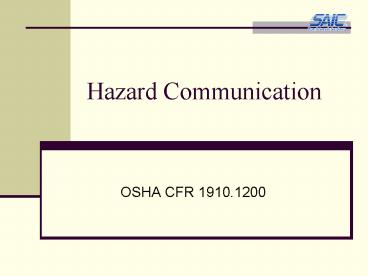Hazard Communication - PowerPoint PPT Presentation
1 / 17
Title:
Hazard Communication
Description:
All employees will prohibit label removal while in service ... Background Information: Hazard Identification System poster. PPE: Same. Questions? Test ... – PowerPoint PPT presentation
Number of Views:193
Avg rating:3.0/5.0
Title: Hazard Communication
1
Hazard Communication
- OSHA CFR 1910.1200
2
Todays Training
- Hazcom Program specific details
- MSDS contents (Overview)
- Summary
3
Hazard Communication
- 29 CFR 1910.1200, "Hazard Communication".
4
Hazard Communication (Hazcom)
- Employee Right To Know Act
- Each employee has the right to know what
chemicals they are working with - How it can effect them from both a health or
physical hazard - Health Hazard effect your vital organs such as
lungs, heart, kidneys, liver and more - Physical hazards are flash points, pH, PELs and
other hazards that can start fires or cause you
bodily harm
5
Hazard Evaluation
- Each Facility will evaluated/inventory hazards
associated with chemicals used in the workplace. - No product or sample will be brought into the
facility prior to hazard evaluation review and
approval. - Facility safety manager will assign C-Number
which will approve the product for use in the
facility.
6
Written Hazcom Plan (Program Details)
- All products must be labeled before use in the
facility - Label must have product name and C-number
(chemical number) - MSDSs will be managed by the site safety manager
- The MSDS binder will be located by the flammables
cabinet or with the safety manager. - C-Numbers will be assigned by facility safety
manager. - No chemical must be active in facility before
C-Number is assigned - An index of C-Numbers will be found in front of
the MSDS Binder - All employees can fill out labels for chemicals
- Sample labels are found in the MSDS book on the
particular MSDS sheet cover. - All employees will prohibit label removal while
in service - All labels/signs must be legible and prominently
displayed on all tanks/containers. All labels
are require the manufacturer and C-number
7
Material Safety Data Sheets
- There is no standard MSDS format
- MSDS's for discontinued chemical or products will
remain on file for 30 years after last usage. - MSDS files will be readily accessible to
employees at all times. - Employee(s) requesting a MSDS(s) must submit
their request to Team Leader. It must be given
to the employee within 3 days.
8
MSDS Review (core contents)
- Section 1. Material Identification
- Identifies the material and supplier along with
emergency phone no. - Section 2. "Ingredients and Hazards
- Lists individual hazardous chemicals in the
product - Lists established safe exposure limits
- PEL - OSHA (permissible exposure limit),
- STEL 15 minutes of exposure per day
- TLV Threshold Limit Value the exposure should
never rise above. - What jobs would this include for evaluation
grinding, sanding, drilling, painting (epoxy) and
other activities
9
MSDS Review
- Section 3. First Aid
- Section 4. "Physical Data"
- Information about product's characteristics such
as Flash point, pH, boiling point, specific
gravity, evaporation rate, etc. - pH (Potential Hydrogen)
- Vapor Density (Air)
- Specific Gravity (Water)
10
MSDS Review
- Section 5. "Fire and Explosion Data
- Shows flashpoint (if any)
- LEL and UEL
- LEL is the most important level because it takes
less substance to ignite. - Protective equipment needed by fire fighter
personnel - Means to extinguish fire
- Section 6. "Reactivity Data"
- Hazardous Decomposition
11
MSDS Review
- Section 7. "Health Hazard Information
- Describes routes of entry into the human body
- Describes acute (immediate) and chronic
(long-term) health effects - (LD50 Injection) (LC-50 is respiratory)
- Lists medical and first aid treatment for
accidental overexposure. - Section 8. "Spill, Leak and Disposal Procedures
- Describes methods to protect health and
environment in case of spill.
12
MSDS Review
- Section 9 Control Measures
- PPE recommendations
- Ventilation
- Work hygiene
- Section 10 Transportation Data
- DOT labeling
- Section 11 Regulatory Information
- EPA reporting regulations
- Section 12 Label Data
- NFPA recommendations (Health, Flammability and
Reactivity)
13
Labeling - NFPA
14
Labeling Requirements
- Each Label will require the following
information - Label on product before being used in the
facility - Manufacturing Name
- NFPA Hazard Rating (all categories filled out)
- Chemical Number (C-Number)
- Each label securely attached to the product
- Copy of label will be on sheet protector in MSDS
book, just copy information
15
Summary
- Written plan located in Facility Safety Manager
- Labels Same
- MSDS Same
- Inventories Same
- Background Information Hazard Identification
System poster - PPE Same
16
- Questions?
17
Test
- Who is responsible for assigning a C?
- Where do I find a copy of the label that goes on
my product? - Where do I find the MSDS Binder?
- Is Vapor Density related to air density or water
density? - Using the NFPA Hazard Index for our labeling
system which number would represent more danger 1
or 4?































